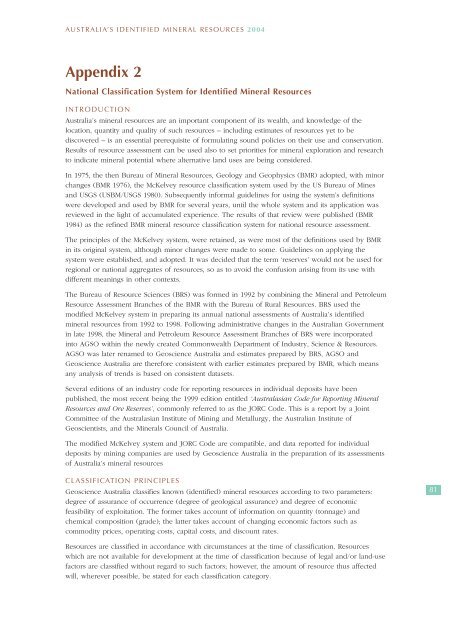australia's identified mineral resources 2004 - Geoscience Australia
australia's identified mineral resources 2004 - Geoscience Australia
australia's identified mineral resources 2004 - Geoscience Australia
Create successful ePaper yourself
Turn your PDF publications into a flip-book with our unique Google optimized e-Paper software.
AUSTRALIA’S IDENTIFIED MINERAL RESOURCES <strong>2004</strong><br />
Appendix 2<br />
National Classification System for Identified Mineral Resources<br />
INTRODUCTION<br />
<strong>Australia</strong>’s <strong>mineral</strong> <strong>resources</strong> are an important component of its wealth, and knowledge of the<br />
location, quantity and quality of such <strong>resources</strong> – including estimates of <strong>resources</strong> yet to be<br />
discovered – is an essential prerequisite of formulating sound policies on their use and conservation.<br />
Results of resource assessment can be used also to set priorities for <strong>mineral</strong> exploration and research<br />
to indicate <strong>mineral</strong> potential where alternative land uses are being considered.<br />
In 1975, the then Bureau of Mineral Resources, Geology and Geophysics (BMR) adopted, with minor<br />
changes (BMR 1976), the McKelvey resource classification system used by the US Bureau of Mines<br />
and USGS (USBM/USGS 1980). Subsequently informal guidelines for using the system’s definitions<br />
were developed and used by BMR for several years, until the whole system and its application was<br />
reviewed in the light of accumulated experience. The results of that review were published (BMR<br />
1984) as the refined BMR <strong>mineral</strong> resource classification system for national resource assessment.<br />
The principles of the McKelvey system, were retained, as were most of the definitions used by BMR<br />
in its original system, although minor changes were made to some. Guidelines on applying the<br />
system were established, and adopted. It was decided that the term ‘reserves’ would not be used for<br />
regional or national aggregates of <strong>resources</strong>, so as to avoid the confusion arising from its use with<br />
different meanings in other contexts.<br />
The Bureau of Resource Sciences (BRS) was formed in 1992 by combining the Mineral and Petroleum<br />
Resource Assessment Branches of the BMR with the Bureau of Rural Resources. BRS used the<br />
modified McKelvey system in preparing its annual national assessments of <strong>Australia</strong>’s <strong>identified</strong><br />
<strong>mineral</strong> <strong>resources</strong> from 1992 to 1998. Following administrative changes in the <strong>Australia</strong>n Government<br />
in late 1998, the Mineral and Petroleum Resource Assessment Branches of BRS were incorporated<br />
into AGSO within the newly created Commonwealth Department of Industry, Science & Resources.<br />
AGSO was later renamed to <strong>Geoscience</strong> <strong>Australia</strong> and estimates prepared by BRS, AGSO and<br />
<strong>Geoscience</strong> <strong>Australia</strong> are therefore consistent with earlier estimates prepared by BMR, which means<br />
any analysis of trends is based on consistent datasets.<br />
Several editions of an industry code for reporting <strong>resources</strong> in individual deposits have been<br />
published, the most recent being the 1999 edition entitled ‘Australasian Code for Reporting Mineral<br />
Resources and Ore Reserves’, commonly referred to as the JORC Code. This is a report by a Joint<br />
Committee of the Australasian Institute of Mining and Metallurgy, the <strong>Australia</strong>n Institute of<br />
Geoscientists, and the Minerals Council of <strong>Australia</strong>.<br />
The modified McKelvey system and JORC Code are compatible, and data reported for individual<br />
deposits by mining companies are used by <strong>Geoscience</strong> <strong>Australia</strong> in the preparation of its assessments<br />
of <strong>Australia</strong>’s <strong>mineral</strong> <strong>resources</strong><br />
CLASSIFICATION PRINCIPLES<br />
<strong>Geoscience</strong> <strong>Australia</strong> classifies known (<strong>identified</strong>) <strong>mineral</strong> <strong>resources</strong> according to two parameters:<br />
degree of assurance of occurrence (degree of geological assurance) and degree of economic<br />
feasibility of exploitation. The former takes account of information on quantity (tonnage) and<br />
chemical composition (grade); the latter takes account of changing economic factors such as<br />
commodity prices, operating costs, capital costs, and discount rates.<br />
81<br />
Resources are classified in accordance with circumstances at the time of classification. Resources<br />
which are not available for development at the time of classification because of legal and/or land-use<br />
factors are classified without regard to such factors; however, the amount of resource thus affected<br />
will, wherever possible, be stated for each classification category.

















